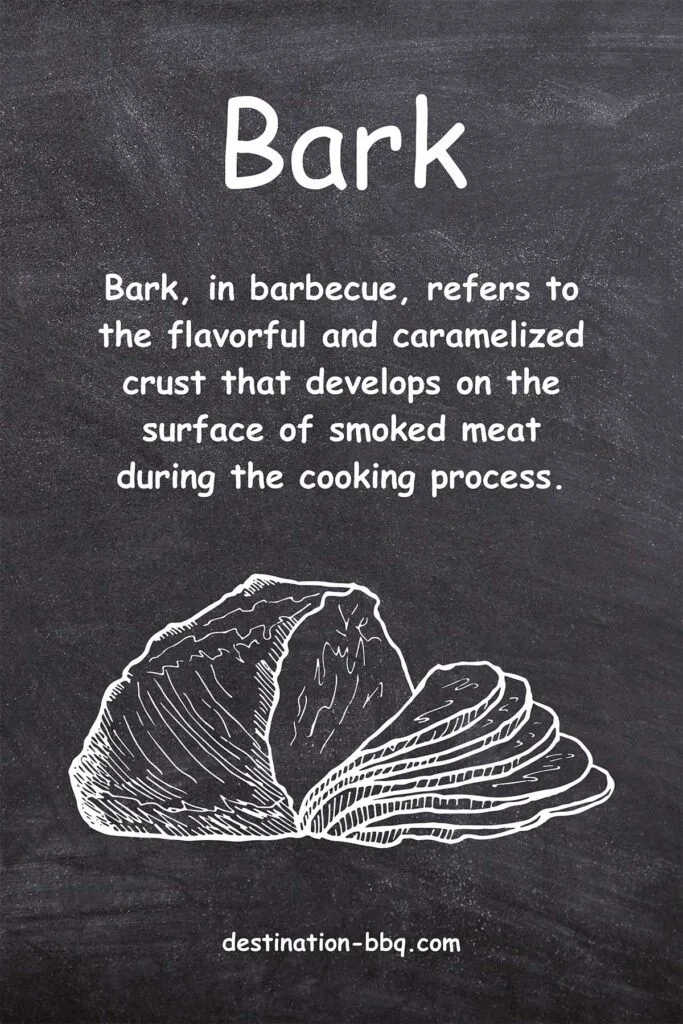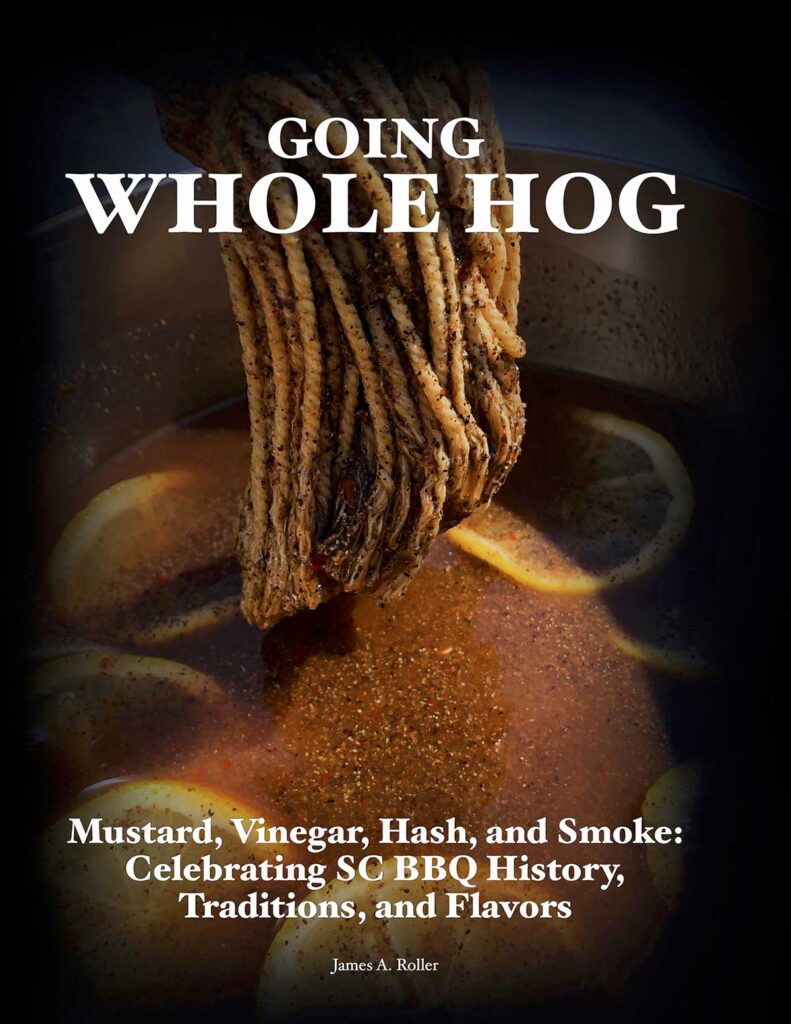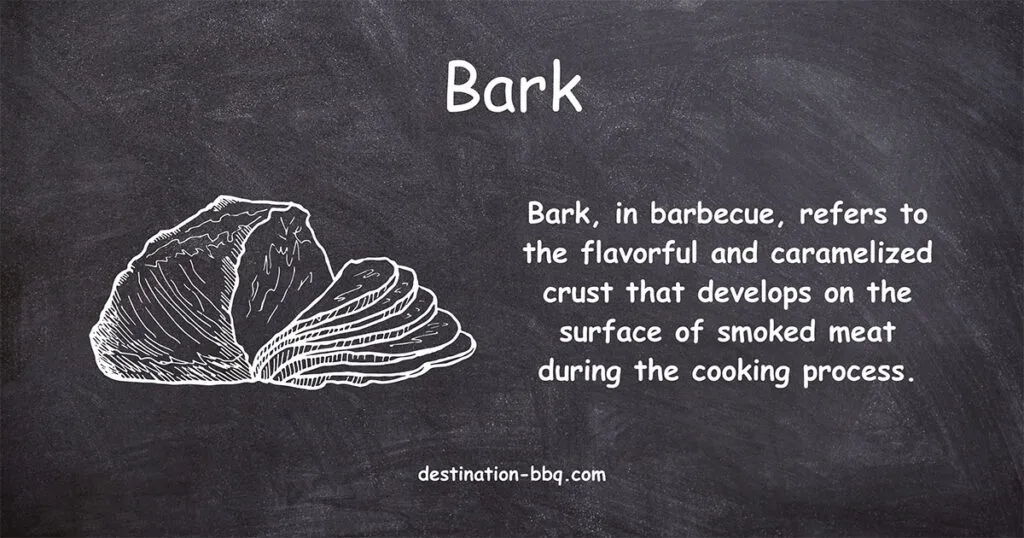
What is Bark in Barbecue?
Bark (also called “Mr. Brown”), in the context of barbecue, refers to the flavorful crust that forms on the surface of smoked meat during the cooking process. It is the result of complex chemical reactions, including the Maillard reaction and polymerization, that occur when meat is exposed to low and slow smoking temperatures. Bark contributes to the texture, flavor, and visual appeal of barbecue, providing a satisfying crunch, rich color, and a depth of savory and smoky notes.
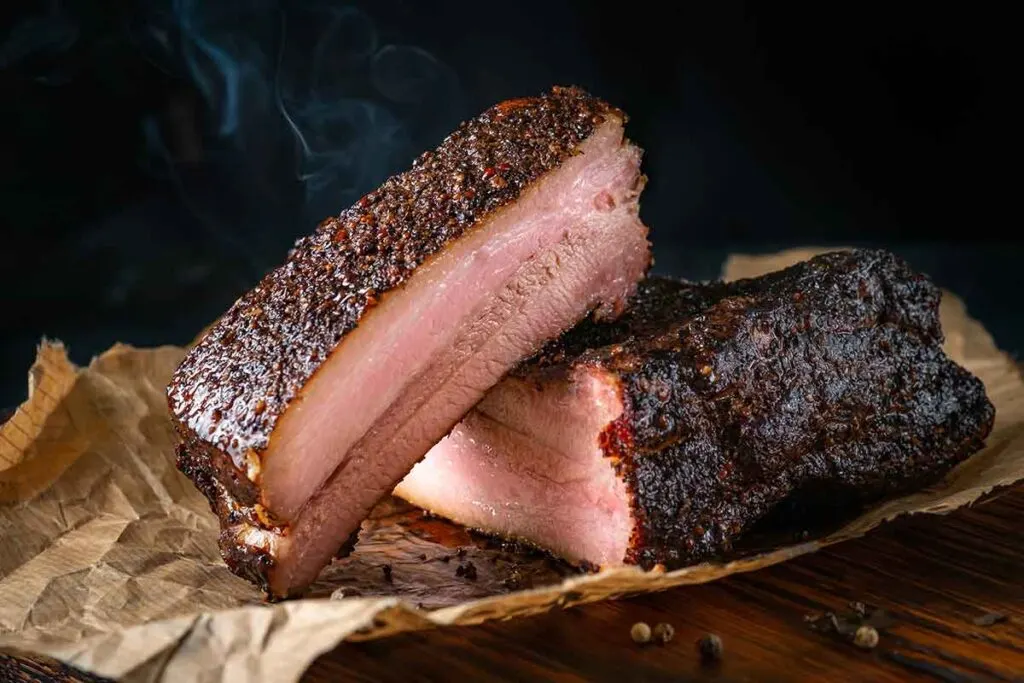
Key Takeaways
- Bark refers to the flavorful crust that develops on the surface of smoked meat during barbecue, created through the Maillard reaction and polymerization.
- It adds texture, visual appeal, and a depth of flavor to the meat, with a range of savory, smoky, and sometimes subtly sweet notes
- Factors such as the type of meat, choice of wood, rub or seasoning, and cooking techniques influence the formation and quality of the bark.
- Bark is highly sought-after by barbecue enthusiasts, often considered the best part of the meat due to its distinct taste and pleasing texture.
Understanding Bark
“Bark is the money. It’s where all the flavor is. It’s where all the seasoning is. It’s where all the love is. It’s the first thing I look for when I’m slicing a brisket.”
– Leonard Botello IV, pitmaster and owner of Truth BBQ
In the world of barbecue, there is a revered element known as bark—the flavorful crust that develops on the surface of smoked meat. Pitmasters and barbecue enthusiasts alike appreciate the significance of bark as it contributes to the overall taste and texture of the meat. This article delves into the science and art of bark formation, exploring the insights shared by pitmasters about this coveted feature.
Bark refers to the dark, crusty exterior that forms on the surface of meat during the smoking or grilling process. This crusty exterior plays a significant role in enhancing the overall flavor, texture, and visual appeal of the meat. It is a highly valued characteristic of barbecue and often scores high in BBQ competitions.
The formation of bark involves a series of chemical reactions, mainly the Maillard reaction, which happens when the meat’s proteins and sugars are exposed to heat. Polymerization is also involved. These reactions lead to the creation of the pellicle and the browning and caramelization of the meat’s surface, thus contributing to the formation of the crusty bark.
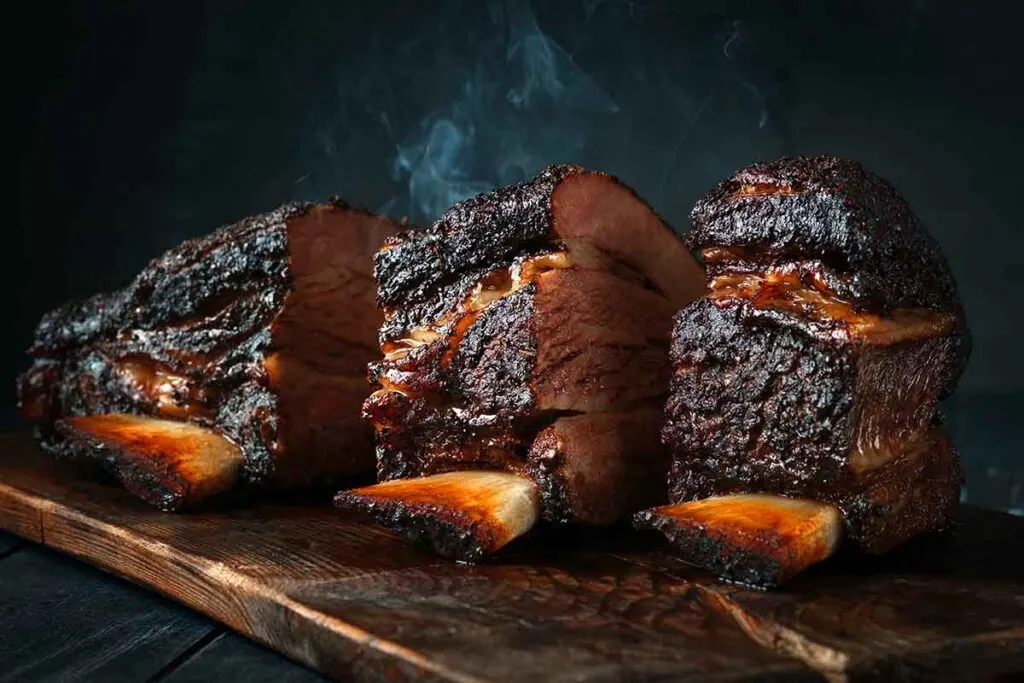
Science Behind the Process
The formation of bark relies on several factors. The application of a balanced spice rub containing sugar, salt, and various spices enhances the flavor and contributes to the development of the crust. The meat is also exposed to smoke, which adheres to its surface, infusing it with a deep, smoky flavor and creating the characteristic dark color of the bark.
As the meat cooks, it releases moisture. This moisture dissolves the water-soluble ingredients in the rub, deepening the flavor and aiding in the formation of the bark. Maintaining an appropriate temperature is critical. Cooking at a low and slow temperature, typically between 200-300°F, supports the formation of a flavorful bark without burning the meat.
Polymerization is a chemical process that involves combining several small molecules, known as monomers, to form a larger, more complex structure known as a polymer. This process is integral to the formation of bark during the barbecuing or smoking process.
In the context of bark formation, polymerization primarily involves the proteins on the surface of the meat. As the meat cooks, it releases moisture, which evaporates over time. This evaporation causes the surface proteins to bond together, forming polymers.
The Maillard reaction, a chemical reaction between amino acids and reducing sugars, also plays a significant role in this process. As the meat is exposed to heat, the Maillard reaction occurs, leading to the browning and caramelization of the meat’s surface. This reaction also leads to the creation of new flavor compounds, contributing to the rich, complex taste of the bark.
The polymers that form on the meat’s surface create a hardened layer, also known as the pellicle or bark. This layer is often rich in color and has a crunchy texture, contributing to the characteristic appearance and texture of well-barbecued or smoked meat.
It’s worth noting that this process is influenced by several factors, including the type of meat, the seasoning used, the cooking temperature, and the cooking time. By carefully controlling these factors, it’s possible to influence the polymerization process and achieve a desirable bark.

Explain It Like I’m a Kid
Creating bark is kind of like a science experiment. It happens through cool chemical reactions, like the Maillard reaction and polymerization.
First, you put a mix of spices on the meat, things like salt, pepper, sugar, and paprika. When you start to cook the meat slowly, some of the spices dissolve in the water that comes out of the meat and the water in the smoke, making a kind of thick, spicy soup on the meat’s surface. At the same time, fats from the meat also mix with the spices.
However, most of these spices can’t go deep into the meat. They mostly stay on the surface, making a sort of glaze. The meat is like a bunch of tiny water balloons; the spices are too big to get inside, but something small like salt can.
When smoke sticks to this spicy layer, it changes the color. Without smoke, the outside of the meat looks like a dark reddish-brown. But with enough smoke and time, it can turn black and shiny, kind of like black licorice. This is why some barbecued meats can look like they’ve been burnt, but they don’t taste burnt at all.
As the meat cooks, water evaporates, kind of like sweat, which cools down the meat and makes the cooking process slower. The spice mix doesn’t stop this from happening. Also, even though we often think of sugar turning brown when it gets hot, the sugar in the spice mix doesn’t get hot enough to turn brown when you’re cooking at low temperatures.
Finally, the spicy layer dries out, and that’s when the Maillard reaction starts. This reaction changes the way the outside of the meat looks and tastes. The proteins beneath the spices stick together to make a type of compounds called polymers, creating a thin skin, or pellicle, underneath the spice crust. This skin doesn’t go away once it’s formed.
Interestingly, the spices you use don’t affect how this skin forms. Also, while the fats make the meat look shiny and help keep the spices on the surface, they don’t help make the bark. So, it’s better to remove most of the fat before cooking.
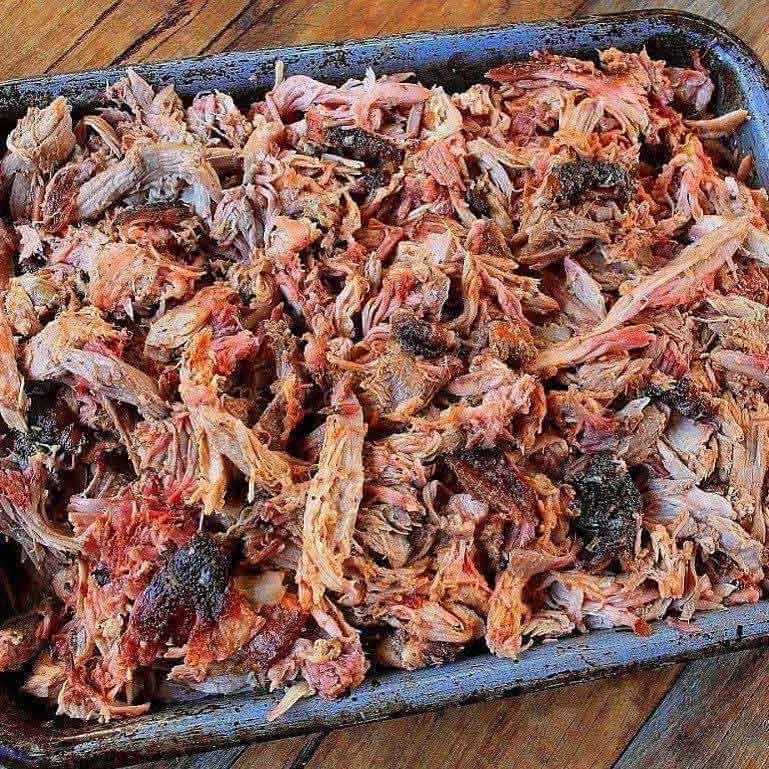
Techniques and Tips for Bark Formation
Successful bark formation isn’t difficult, but it can be fostered by using certain strategies before and during cooking.
- Use a well-balanced spice rub: Rubs contain a mixture of seasonings that enhance the flavor of the meat and contribute to bark formation.
- Dry the meat before applying rub: Pat the meat dry with paper towels before adding the rub to ensure it adheres well and promotes a better bark formation.
- Manage moisture levels: As the meat cooks, it should release enough moisture to dissolve the rub, but not so much that it prevents the bark from forming.
- Maintain proper temperature: A consistent low temperature, usually between 200-300°F, is essential for slow-cooking the meat and allowing the bark to develop without burning.
- Maximize smoke exposure: Smoke is crucial for adding flavor and achieving the dark color characteristic of bark. Different types of wood will provide different smoke flavors.
- Increase the meat’s surface area: Cutting large cuts into smaller portions or making gashes in the meat allows the rub to penetrate more deeply and a larger area for bark to form.
- Avoid foil wrapping during cooking: While foil is fine when used properly (see 3-2-1 method), foil can create excess moisture and inhibit bark formation when used incorrectly or at the wrong point in the cook.
- Trim excess fat: Too much fat can prevent a proper bark from forming. It’s best to leave only a thin layer of fat on the meat.
Common Mistakes to Avoid
Despite the best intentions, common mistakes can impede the formation of quality bark. These include the following:
- Using too much heat: Cooking barbecue at high temperatures can cause the meat to burn on the outside before it’s fully cooked on the inside, ruining the bark.
- Not enough smoke: Smoke plays a crucial role in bark formation, providing flavor and aiding in the Maillard reaction. Without enough smoke, the bark may lack flavor and color.
- Rushing the process: Good barbecue and bark formation take time. Cooking too quickly can result in an underdeveloped bark.
- Applying rub unevenly: An uneven application of rub can result in a patchy bark. The rub should be evenly distributed for a consistent bark.
- Not managing moisture: While moisture is needed for the cooking process, too much can lead to a soggy bark. It’s essential to strike a balance.
- Leaving too much fat: While some fat is beneficial, an excessive amount can interfere with bark formation, causing it to become overly charred and negatively affecting texture and flavor.
- Neglecting temperature control: Maintaining a consistent, low temperature is critical for slow cooking and achieving the desired bark. Fluctuating temperatures can lead to uneven cooking and bark development.
- Not drying the meat surface before applying the rub: If the meat surface is not dried, the rub may not stick properly, and to dry the surface of the meat before, helping the rub adhere better and promoting better bark formation.
Final Words
Bark is a significant element of barbecue, offering a combination of flavor, texture, and visual appeal. Understanding the factors and techniques for bark formation, such as the spice rub, smoke, moisture, temperature, and fat management, empowers grillers to achieve desired results. By avoiding common mistakes and following the provided guidelines, barbecue enthusiasts can consistently produce a quality bark that enhances their barbecue experience.
